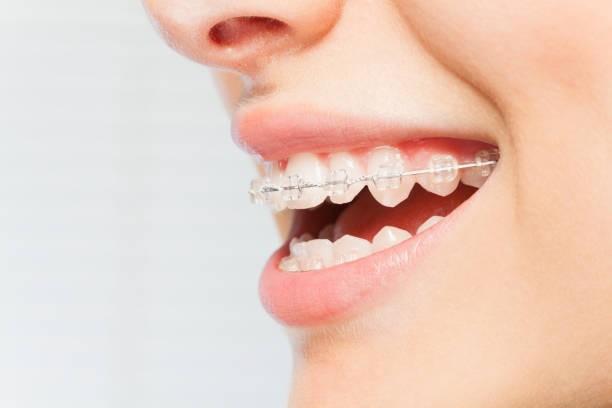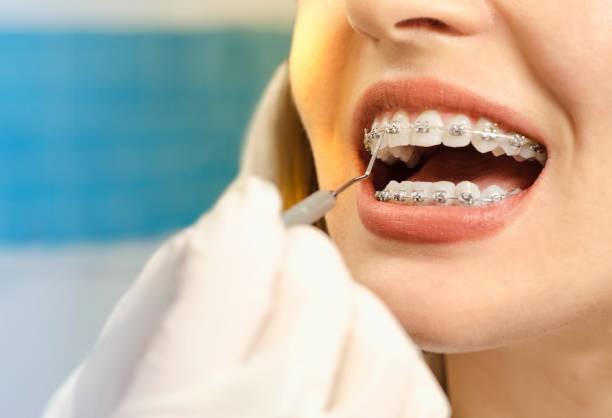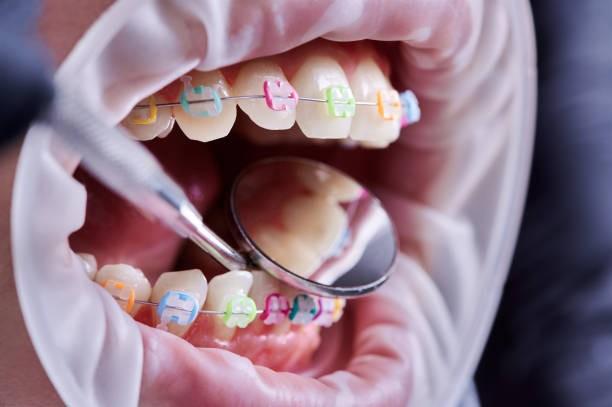
Most people who are insecure about their teeth or who want to straighten them up tend to go for braces. However, some may go for braces purely on an aesthetic basis. Whether it is medically or aesthetic, knowing the cost of braces is essential.
In Canada, the Canada Health Act (CHA) does not cover general oral and dental health care. As such, you must get insurance if you don’t want to spend too much from your pocket.
In this article, we will carefully proffer answers to the question, “How much do braces cost in Canada with insurance?” and provide other essential information you need to know.

How Much Do Braces Cost In Canada With Insurance
This is one of the most popular questions among Canadians planning to get braces. The average cost for braces in Canada is $5,000 to $6,000; some people can pay as much as $10,000.
The cost of braces with insurance varies depending on factors such as your insurance coverage and the specific treatment needed. Dental insurance plans in Canada may cover a portion of the brace’s cost. Still, the exact coverage and out-of-pocket expenses will depend on your specific insurance policy.
Your dental insurance covers a percentage of the total cost, typically 50% to 80%. The rest of the expense would be your responsibility.
You should contact your dental insurance provider to get a more accurate estimate and inquire about your orthodontic coverage. Additionally, consider scheduling a consultation with an orthodontist who can provide a personalized treatment plan and a more precise cost estimate based on your specific needs and insurance coverage.
I was sitting with my friend the other day, chatting about life. She had just gotten her braces put on and she was excited, but also a bit anxious about the cost. She told me that when she got her braces in Canada, she had to get insurance in order to cover the costs.
She said that it could range from $5,000 to $10,000 depending on the complexity of the treatment and the coverage of her insurance policy. As we talked more, I could see her emotion starting to build as she thought about how much this was going to cost her.
She shared with me all of her worries: How much would be covered by her insurance? Would she have enough money saved up to cover the rest? Would this affect other aspects of her life such as travel plans or daily expenses? My heart went out to my friend as I listened to her story and all of her concerns. I reassured her that no matter what happened it would be okay and that there must be a way for us to figure it out together.
We brainstormed ideas on how she could afford the cost of braces and eventually settled on some feasible solutions like talking to an orthodontist about payment plans or asking family members for help if needed. Although it is not an easy process, I’m glad that we were able to talk through it together and come up with some solutions for my friend. It’s moments like these where I am reminded that sometimes you just need someone who will listen without judgment in order for you to find clarity and peace with your decisions.
Disclosure: My site is reader-supported. I may get commissions when you click through the affiliate links (that are great products I use and stand by) on my articles.

Braces Cost In Canada With Insurance
- Most people who are insecure about their teeth or who want to straighten them up tend to go for braces.
- In Canada, the Canada Health Act (CHA) does not cover general oral and dental health care.
How Does Dental Insurance Work In Canada?
 Dental insurance in Canada works similarly to other types of health insurance. It is designed to help individuals and families cover the costs of dental treatments and services, such as routine check-ups, cleanings, fillings, X-rays, and basic dental procedures.
Dental insurance in Canada works similarly to other types of health insurance. It is designed to help individuals and families cover the costs of dental treatments and services, such as routine check-ups, cleanings, fillings, X-rays, and basic dental procedures.
Dental insurance plans may have a deductible, which you must pay out of pocket before the insurance coverage kicks in. For example, if your deductible is $200, you’ll need to pay the first $200 in dental expenses, and the insurance will start covering costs beyond that amount. Even after the deductible is met, dental insurance plans often require co-payments or coinsurance. This means you’ll be responsible for paying a percentage of the dental treatment costs while the insurance company covers the remaining percentage.
Also, dental insurance plans may have annual limits on the amount of coverage they provide. For example, a plan may have a maximum coverage limit of $1,500 annually. If your dental expenses exceed this limit, you’ll be responsible for the remaining costs out of pocket.
Furthermore, some dental insurance plans have waiting periods before covering certain services. This means you may need to wait a specified period (e.g., three to six months) before being eligible for coverage for certain treatments.
The Types Of Dental Insurance Financing
There are four common types of dental insurance financing, and they are as follows:
Traditional Dental Insurance:
This is the most common type of dental insurance financing. With traditional dental insurance, individuals or employers pay a premium to an insurance company. In return, the insurance company provides coverage for specific dental treatments and services. Coverage levels, deductibles, co-payments, and annual limits can vary based on the insurance plan.
Employer-Sponsored Dental Plans
Many employers offer dental insurance as part of their employee benefits package. In these plans, the employer negotiates group rates with dental insurance providers, making the coverage more affordable for employees. Employees may have the option to choose from different levels of coverage based on their needs and budget.
Private Dental Insurance
Private dental insurance is dental coverage that individuals or families purchase directly from a private insurance provider rather than receiving as part of an employer-sponsored benefits package.
This type of dental insurance gives individuals more control over their coverage options and tailor the plan to their specific dental needs. Unlike some employer-sponsored plans, private dental insurance often allows individuals to visit any dentist, whether in-network or out-of-network providers. However, visiting in-network dentists may lead to lower out-of-pocket costs.
Government-Subsidized Dental Programs
Government-subsidized dental programs are initiatives governments implement at various levels (federal, provincial, or local) to provide dental care assistance and services to specific populations or individuals who may face financial barriers to accessing dental care.
Below is the list of provinces. You can click on any of them and view the government-subsidized dental programs available.
- Alberta
- British Columbia
- Manitoba
- New Brunswick
- Newfoundland and Labrador
- Northwest Territories
- Nova Scotia
- Nunavut
- Saskatchewan
- Ontario
- Prince Edward Island
- Québec
- Yukon
What Does Dental Insurance Cover In Canada?
Most dental insurance plans in Canada typically cover a range of dental treatments and services. Here are some common dental services that may be covered by dental insurance in Canada:
- Preventive services such as regular check-ups, dental cleanings, and X-rays.
- Basic dental treatments include fillings, simple extractions, and emergency dental care.
- Periodontal (gum) care
- Major dental treatments include crowns, bridges, dentures, root canals, and surgical extractions.
- Orthodontic treatments, including braces or clear aligners.
- Oral surgical procedures like wisdom teeth extractions and other necessary surgical treatments.
- Diagnostic services like oral examinations and consultations with dental professionals.

Braces Cost In Canada With Insurance
- Most people who are insecure about their teeth or who want to straighten them up tend to go for braces.
- In Canada, the Canada Health Act (CHA) does not cover general oral and dental health care.
Does Dental Insurance Cover Pre-Existing Conditions?

The coverage of pre-existing conditions under dental insurance varies depending on the insurance provider’s policies and plans. Generally, dental insurance plans may have certain limitations or exclusions related to pre-existing conditions.
Dental insurance providers may define pre-existing conditions differently. Some may consider any dental condition that existed before the start of the insurance coverage as pre-existing, while others may have specific criteria and waiting periods.
Even if a dental insurance plan excludes coverage for pre-existing conditions, it may still cover preventive care services like routine check-ups, cleanings, and X-rays.
What Does Dental Insurance In Canada Exclude?
Dental insurance plans in Canada may have certain exclusions or limitations on coverage. While the specific exclusions may differ, here are some common types of treatments and services that dental insurance in Canada may exclude:
Pre-existing Conditions:
Some dental insurance plans may have exclusions for pre-existing dental conditions, meaning treatments related to dental issues that existed before the start of the insurance coverage may not be covered.
Cosmetic Dentistry:
Dental insurance typically excludes purely cosmetic treatments that are not medically necessary. Examples of cosmetic procedures that may not be covered include teeth whitening and veneers for aesthetic purposes.
Orthodontic Treatments for Adults:
While some dental insurance plans cover orthodontic treatments for children and teenagers, they may exclude or limit coverage for adults.
Dental Implants:
Dental insurance plans may not cover the cost of dental implants used to replace missing teeth surgically. Some plans may provide limited coverage for implant-supported prosthetics.
Oral Surgery for Non-Medical Reasons:
Some dental procedures, such as certain types of jaw surgeries or procedures for non-medical reasons, may not be covered by dental insurance.
Experimental or Investigational Procedures:
Dental insurance plans may exclude coverage for treatments considered experimental, investigational, or not widely accepted within the dental community.
Certain Restoration Materials:
Dental insurance plans may limit coverage for specific types of dental restoration materials, especially if they are considered premium or cosmetic.
Services Not Performed by Dentists:
Some dental insurance plans may not cover treatments performed by non-dentist professionals, such as oral health therapists or dental hygienists.
Third-Party Treatments:
Dental insurance plans may exclude coverage for treatments performed by third-party providers or individuals not in the dental plan’s network.
Replacement of Lost or Stolen Items:
Dental insurance may not cover the replacement cost for dental devices or appliances, such as lost dentures or mouthguards.
How Much Does Dental Insurance Cost?
The cost of dental insurance can vary significantly depending on several factors, including the type of plan, the level of coverage, the insurance provider, your location, and the number of individuals covered by the plan.
Dental insurance can be purchased through various sources, including employer-sponsored, individual, and family plans. Here are some general cost considerations for different types of dental insurance: On average, individual dental insurance costs can range from $20 to $50 per month, while family dental insurance premiums can range from $50 to $150 per month.

Braces Cost In Canada With Insurance
- Most people who are insecure about their teeth or who want to straighten them up tend to go for braces.
- In Canada, the Canada Health Act (CHA) does not cover general oral and dental health care.
How Much Does Dental Care Cost In Canada?
 The cost of dental care in Canada can vary depending on factors, including the specific treatment or procedure needed, the location of the dental practice, the dentist’s experience, and whether the patient has dental insurance coverage.
The cost of dental care in Canada can vary depending on factors, including the specific treatment or procedure needed, the location of the dental practice, the dentist’s experience, and whether the patient has dental insurance coverage.
Here are some approximate costs for common dental treatments in Canada:
Dental Check-Up and Cleaning:
The cost of a routine dental check-up and cleaning can range from $80 to $200, and it depends on the complexity of the cleaning and the dentist’s fees.
Tooth Filling:
The cost of a dental filling for a cavity can vary depending on the filling material used. A basic amalgam (silver) filling may cost between $100 to $250 per tooth, while a tooth-colored composite filling can cost between $150 to $400.
Dental X-Rays:
The cost of dental X-rays can vary based on the number of X-rays taken and the type of X-ray technology used. On average, dental X-rays may cost between $30 to $200.
Tooth Extraction:
A tooth extraction may range from $100 to $300 per tooth. More complex extractions, such as wisdom teeth removal, may cost more.
Root Canal Treatment:
A root canal treatment can cost $800 to $1,500 on average, depending on the complexity of the tooth.
Dental Crowns:
The cost of dental crowns depends on the material used (e.g., porcelain, metal, porcelain-fused-to-metal). A dental crown may cost between $800 to $1,500 per tooth.
Dental Bridges:
The cost of dental bridges, used to replace missing teeth, can vary depending on the number of missing teeth and the type of bridge. A dental bridge may cost between $2,000 to $5,000 or more.
Dentures:
The cost of dentures depends on whether they are partial or full dentures and the materials used. The cost range from around $1,000 to $3,000 or more for a complete set of dentures.
Orthodontic Treatment (Braces or Aligners):
The cost of orthodontic treatment varies based on the complexity of the case, the type of braces or aligners used, and the duration of treatment. Orthodontic treatment may cost between $4,000 to $8,000 or more.
What Is the Cost Of Braces Without Insurance
The cost of braces without insurance is a bit higher. Although the prices of braces vary between provinces and hospitals, here are the average costs of the following type of braces.
- Traditional metal braces: $3,000 – 7,000
- Ceramic braces: $4,000 – 8,000
- Lingual braces: $8,000 – 10,000
- Invisalign: $4,000 – 7,400
People Also Ask:
Does Dental Insurance Cover Braces?
Dental insurance in Canada that offers orthodontic coverage provides coverage for braces, but the extent of coverage and the specific conditions can vary significantly depending on the insurance plan.
What is the Cost of Braces Per Month?
To know the exact monthly cost you will spend on a brace, you must consult your orthodontist. For instance, if the estimate is $5,000, and your treatment will go on for about 24 months, your monthly cost will be about $208.
How Much Do Invisible Braces Cost In Canada?
Invisalign braces, known as invisible braces, cost around $2000-$8000. They can be more expensive than normal braces. Some factors that influence cost include the provider’s experiences and the patient’s age.
Is There Free Dental Programs in Canada
There are no free dental programs in Canada, but the government does sponsor free dental programs. However, you can always get insurance to cover dental services.
How Much Are Braces In Toronto?
The cost of braces in Toronto ranges from around $6000 to $7500, depending on the treatment plan and the severity of the issue being addressed.

Braces Cost In Canada With Insurance
- Most people who are insecure about their teeth or who want to straighten them up tend to go for braces.
- In Canada, the Canada Health Act (CHA) does not cover general oral and dental health care.
Conclusion
The average cost for braces in Canada is $5,000 to $6,000; some people can pay as much as $10,000. The cost of braces with insurance varies depending on factors such as your insurance coverage and the specific treatment needed.
Contact your dental insurance provider for a more accurate estimate and inquire about your orthodontic coverage to get the exact cost. You can also consult an orthodontist for a personalized treatment plan and a more precise cost estimate based on your specific needs and insurance coverage.






